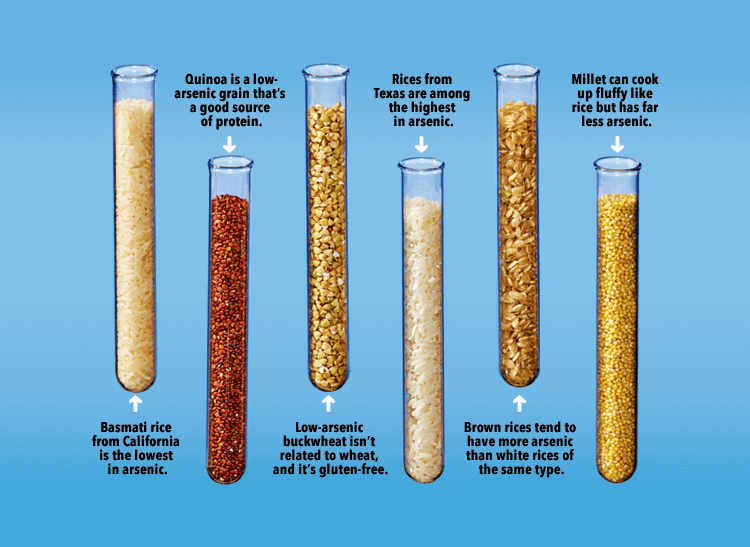Rice and Arsenic? Whats the Truth?
A study done on all 60 varieties of rice – brown, white, organic and non organic, found that all had levels of arsenic!
The study informed parents that they should not be serving their infants more than 1 serving of infant rice cereal a day and to be including other grains instead. The FDA actually recommend that everyone, especially pregnant women, infants, and toddlers, should watch their consumption of rice and try to use whole grains, and other grain cereals for food.
Photo from: https://www.consumerreports.org/cro/magazine/2015/01/how-much-arsenic-is-in-your-rice/index.htm
ARSENIC- Where Does it Come From?!?!
Arsenic is released from the environment through the use of pesticides and poultry fertilizers. Animals are also fed arsenic, (especially chicken.) Due to this – it’s now in our soil and rice, and other grains.
“The USA Rice Federation says, “Studies show that including white or brown rice in the diet provides measurable health benefits that outweigh the potential risks associated with exposure to trace levels of arsenic.”
While this is said by the rice federation, they have a benefit in a higher consumer consumption of rice and the truth about its safety is still not clear. Regular exposure to small amounts of arsenic has been shown to increase the risk of bladder, lung, skin disease, and type 2 diabetes as well as a weakened immune system – especially for babies.
So What Now? I Can’t Eat Rice Anymore?!?!
No, the idea is that you buy rice from areas that have shown to have less arsenic like, basmati rice from: California, India, and Pakistan, and sushi rice from the U.S.
Basmati rice from California has shown to have 38% less arsenic then from other parts of the world.
Brown rice has 80% more arsenic than white rice, however is has lots of other health benefits. If you choose to eat a serving of brown rice try to get basmati from California, India or Pakistan.
SOME TIPS AND TRICKS!
To reduce your consumption, rinse rice thoroughly before cooking. When you cook rice use this method: 6 cups water to 1 cup rice and drain the excess water after.
Yes, you may loose some nutrients the water absorbs but you can also reduce arsenic amount by 30%.
The Consumer Report Blog recommends eating no more than 7 points per week!
2014 Consumer Reports. All rights reserved
|
| PRODUCT | SERVING SIZE | CHILD POINTS 1 | ADULT POINTS 1 |
| Infant Rice Cereal | 1/4 cup, uncooked | 1-1/4 | NA |
| Rice Cereal, Hot | 1/4 cup, uncooked | 8-1/4 | 3-1/2 |
| Rice Cereal, Ready to Eat | 1 cup | 4-1/2 | 2-1/4 |
| Rice Drinks | 1 cup | 4 | 2 |
| White Basmati2 or Sushi Rice | 1/4 cup, uncooked | 2-1/2 | 1-1/2 |
| All Other Rice | 1/4 cup, uncooked | 5-1/2 | 3-1/2 |
| Rice Pasta | 2 ounces, uncooked | 7-1/4 | 3 |
| Rice Cakes | 1 to 3 rice cakes | 6-1/4 | 2-1/2 |
| Rice Crackers | 16 to 18 crackers | 2-3/4 | 1-1/4 |
| Cake or Muffin Mix | 2 to 3 ounces | 3-3/4 | 1-1/2 |
| Brownie Mix | 1 to 2 ounces | 1-1/4 | 1/2 |
| Cookies | 1 to 3 cookies | 1-3/4 | 3/4 |
| Rice Pudding | about 1/3 cup | 1-3/4 | 3/4 |
| Pie- or Pizza-Crust Mix | 2 ounces | 2 | 1 |
| Snack Bars (Cereal, Granola, or Energy) | 1- to 2-ounce bar | 2-3/4 | 1-1/4 |


